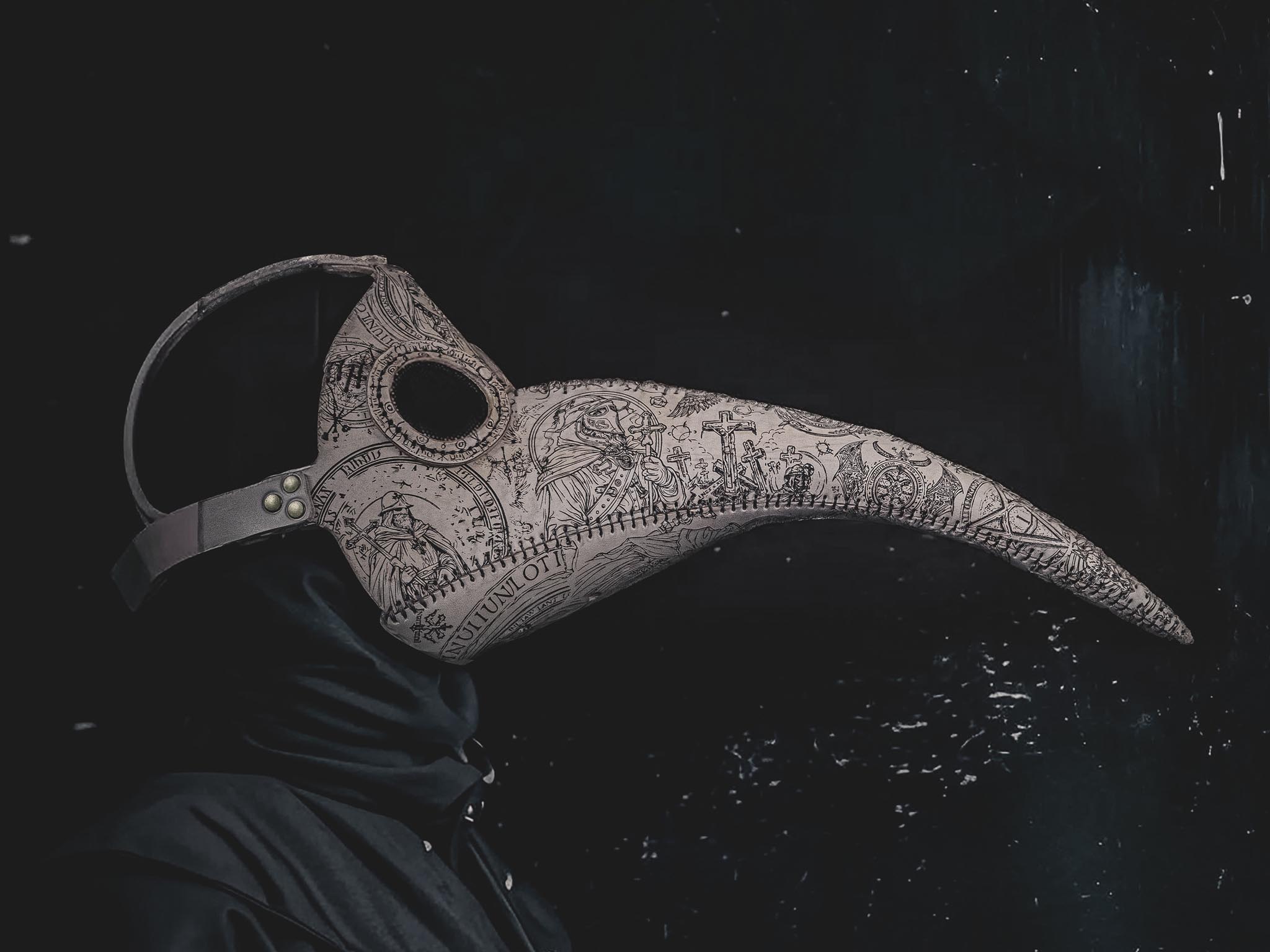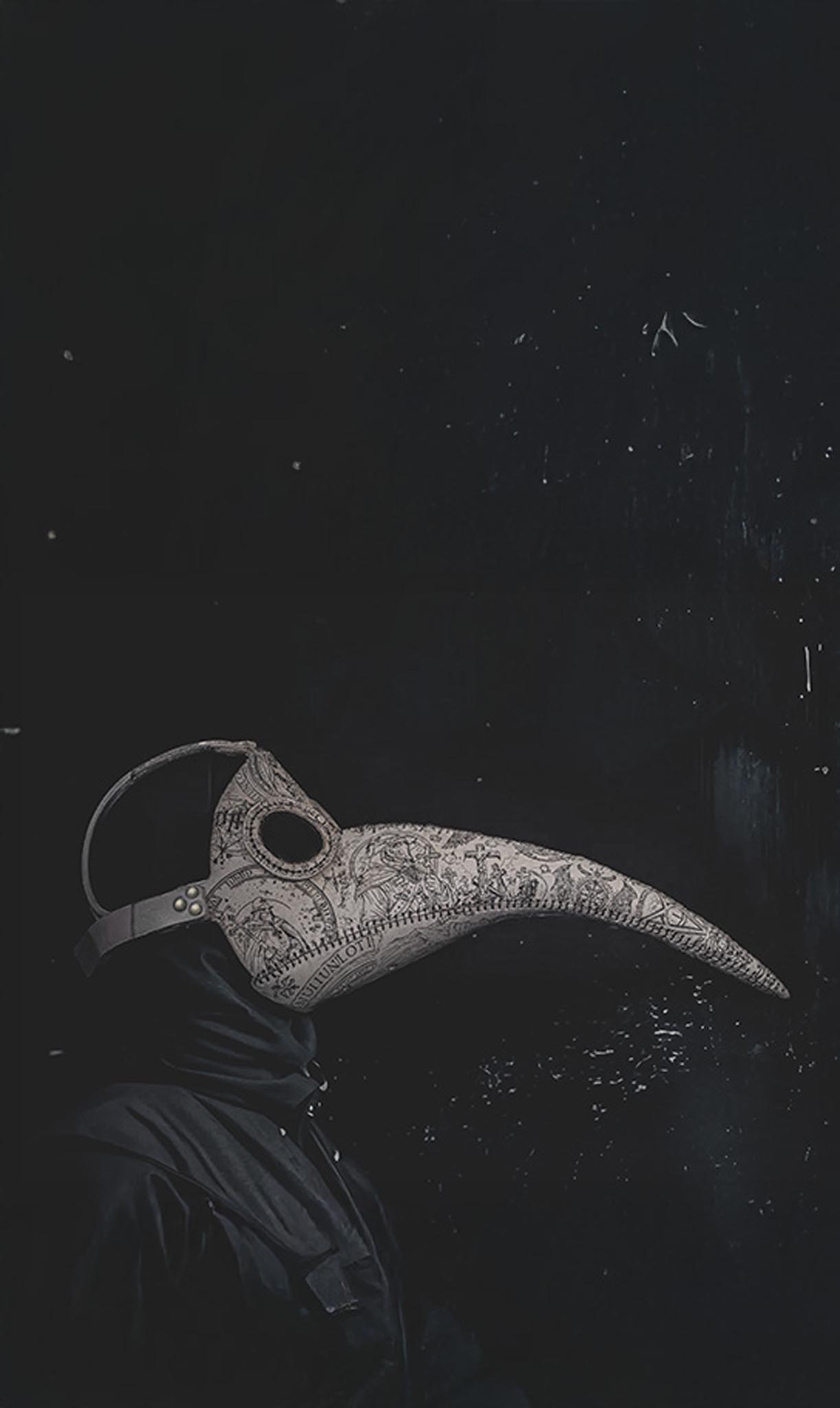Mask of the Physician of Faith: Reconstruction of a 17th Century Ecclesiastical Figure
Based on an archival description
In stock


Mask of the Physician of Faith: Reconstruction of a 17th Century Ecclesiastical Figure
Based on an archival description
In stock
The mask reproduces the appearance of a physician appointed by the Catholic Church during times of plague. It is based on a 1668 manuscript and conveys the symbolism of spiritual duty, where healing gives way to ritual presence and silent witnessing.
In a monastic archive near Rome, a Latin folio titled Liber Medicorum Exorcistae, dated 1668, was discovered. Its fourth section describes a figure whose task lay not in recovery but in accompaniment. He was referred to as medicus fidei – a physician of faith. His face was covered in leather, his hand held a cross, and his speech consisted of a learned prayer. He entered homes where only silence and the scent of incense remained.

Such physicians were granted access to the dying without confession, appointed by ecclesiastical authority. Their charge extended to both body and soul. This was not a professional in the modern sense. His presence marked the final stage. He observed, recorded, performed gestures whose meaning was passed down rather than explained. He stood between life and its closing moment, fulfilling a role rooted in ritual.
The mask created in response to this figure mirrors that internal structure. Its composition follows iconographic principles of the late 17th century – prayer, act, conclusion. At the center is a female figure with joined hands – a sign of intercession. Below stands the physician, facing a burial ground, and further still, the same figure shown as skeletal. Each element belongs to a vertical system. None stands apart. Each supports a vision of duty that continues beyond the body’s end.
Trace in the Archive
In one of the books on 17th-century Catholic iconography, a footnote caught the eye. It mentioned a figure active during plague outbreaks – medicus fidei. There were no illustrations, not even a name. Just a line: “clad in leather, holding a cross, permitted to enter without confession.” That phrase lingered. It carried tension, as if concealing an entire structure lost from view. It felt like a character pushed to the margin of the record, waiting to be reassembled from fragments, tone, and implication.

The search began. The sources were scattered – ecclesiastical decrees, altar reliefs, descriptions of burial rites. Gradually, a structure emerged. This was not an individual in the biographical sense, but an assigned role within a ritual. The physician was designated. He stepped into places where others had withdrawn. He delivered no verdicts and offered no remedies. His task was to be present and to enact gestures whose meaning was established beforehand. He stood within a home as the end unfolded and did so without words.

Once his function became clear, the idea followed: if he belongs to the structure of ritual, the mask must also operate on that level. Not as decoration, but as a form built on internal logic. Each element should carry the composition forward. Not ornament, but point within a system. That was the origin of a piece meant to speak through structure, not image.
What the Engraving Speaks
The composition follows a vertical structure common to late 17th-century religious imagery. Everything is directed along a single axis – from invocation to execution, from action to conclusion. At its visual center stands a female figure with hands joined in prayer. Her face is calm, her posture unmoving. She is enclosed within a circle that resembles a reliquary or emblem. In the iconographic language of the time, such a form signaled intercession – not protection, but presence between the departing and the divine.

Beneath her stands the physician. He remains motionless, his gaze directed beyond the frame. In his right hand, he holds a cross, extended forward, as a confirmation of the role bestowed upon him. The space ahead is a field of Catholic graves – not a backdrop, but a terminus. This is not a moment of dread. It is a still point. A cross marked on his chest, shaped like a sword, reflects a vow taken – a duty carried without need for elaboration, integrated into the logic of the scene.

A third figure appears, unchanged in form but altered in detail. The posture, garments, and cross remain, but the face is reduced to bone. This does not signal destruction. It preserves structure without flesh. Writings from the period often attached to such imagery the phrase usque ad mortem – unto death. The act persists. Presence remains as long as the body retains its bearing, even after substance has gone.
Surrounding the central figure are Latin inscriptions. These are not intended to be read in sequence. They form a circular boundary – a rhetorical frame for meditation. Their purpose is to slow the gaze, hold attention at the core. They operate as visual invocation, drawing the eye inward without offering completion.

The entire sequence is grounded in a continuous landscape. The graves do not serve as decoration. They complete the axis. The land provides rhythm – one into which the physician is placed with finality. Every element of the engraving affirms a single motion: duty as enduring presence, which does not dissolve when the body is no longer present.
The Mask in Hand
The mask gives the impression of an object created with deliberate attention to proportion and material density. Its weight is evenly distributed, and the construction remains stable when placed on a flat surface. The primary material is vegetable-tanned leather, with a hand-finished surface and a final coating of natural wax. The tone gravitates toward a dark gray range, with subtle transitions across the surface. To the touch, the outer texture feels dry, without artificial smoothness. The inner surface is softer and shaped to accommodate the contours of a face.

The engraved design is embedded into the structure. Its lines do not protrude but can be felt through gliding contact. The imagery reveals itself gradually as the mask turns in light. The symbolic content reads as a sequence, uninterrupted by form or composition. No single element draws undue attention – each is integrated into the overall rhythm.
The mask conveys a sense of completeness, with internal cohesion. It does not function as part of a set and does not call for additional framing. It invites prolonged observation – its presence remains steady, resisting simplification. This quality is typically encountered in original objects tied to a specific period.
After Contemplation
This object is not presented as a reconstruction. It does not attempt to restore the outward appearance of a lost era but engages with its internal structure. Archival descriptions, compositional logic from liturgical graphics, and visual principles of ritual practice were all used in its creation. The result is a form that feels complete without being closed. There is no imitation – only a deliberate act of working with memory.

The mask conveys the figure of a physician appointed to act in extreme circumstances. It does not appeal to nostalgia or rely on invention. Each element follows a consistent internal order. With prolonged observation, a sense of presence begins to form – not performative, but physical. One gets the impression that the mask has already fulfilled its task and remains simply to be seen.
The object is available for acquisition. It was produced as a single piece, using materials shaped and finished entirely by hand. Its construction was guided by historical sources and the iconographic logic of its period. This is not a form created to accompany an event. It is a form that preserves the very principle of action. For those who seek to hold something that speaks without language – this piece offers that possibility.
Mask of the Plague Witness
A mask of faith, duty, and judgment
$230.00
Only 1 available
Our other posts






